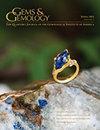Black Diamonds from Marange (Zimbabwe): A Result of Natural Irradiation and Graphite Inclusions
IF 1.6
3区 地球科学
Q2 MINERALOGY
引用次数: 7
Abstract
have either natural or treated color origin. Natural black diamonds are usually colored by inclusions of sulfides, graphite, magnetite, hematite, or iron-bearing inclusions (e.g., Titkov et al., 2003). A rare natural diamond (of undisclosed geographic origin) colored by abundant brown radiation stains has previously been examined by GIA’s Carlsbad laboratory (Ardon, 2013). Treated black diamonds are often those that are heavily fractured naturally and then treated at low-pressure and hightemperature (LPHT) conditions to graphitize the fractures and turn them black (Hall and Moses, 2001; Notari, 2002). Artificial irradiation can also produce dark colors that appear black (Collins, 1982; Kitawaki, 2007). The Marange locality in eastern Zimbabwe is well known for producing diamonds that contain both octahedral and cuboid sectors (mixed-habit diamonds) where the cuboid sectors are visible to the eye due to abundant micro-inclusions of graphite (Rakovan et al., 2014; Smit et al., 2016). These micro-inclusions, informally known in the gem trade as “clouds,” give the diamonds a brown-gray appearance that lowers their value. Heat treatment of these lower-quality graphitecontaining Marange diamonds has the potential to introduce gem-quality treated black diamonds into the market. In natural diamonds, these graphite micro-inclusions are around 1 μm in diameter; during heating above 1200°C, they become larger. After annealing at 1700°C, the grain size increases to 11–16 μm, causing the cuboid sectors to appear opaque black (Eaton-Magaña et al., 2017). The challenge for gem laboratories is to confidently distinguish these treated black diamonds from naturally occurring black diamonds. Here our goal was to document a suite of untreated Marange diamonds, all with Fancy Dark brown to Fancy black GIA color grades, so that their characteristics could be distinguished from any suspected treated black diamonds. When viewing the samples, however, it became clear that the appearance of the these dark Marange diamonds was due not only to graphite clouds but also to abundant graphite needles and dark brown radiation stains occurring within surface-reaching fractures. BLACK DIAMONDS FROM MARANGE (ZIMBABWE): A RESULT OF NATURAL IRRADIATION AND GRAPHITE INCLUSIONS津巴布韦马兰吉黑钻石:自然辐射和石墨包裹体的结果
有天然或处理过的颜色来源。天然黑钻石通常由硫化物、石墨、磁铁矿、赤铁矿或含铁包裹体包裹而着色(例如,Titkov et al., 2003)。GIA的卡尔斯巴德实验室(Ardon, 2013)曾检测过一颗罕见的天然钻石(地理来源未披露),该钻石被大量的棕色辐射染色。经过处理的黑钻石通常是那些天然裂缝严重的钻石,然后在低压和高温(LPHT)条件下进行处理,使裂缝石墨化并使其变黑(Hall和Moses, 2001;Notari, 2002)。人工照射也可以产生黑色的深色(Collins, 1982;Kitawaki, 2007)。津巴布韦东部的马兰吉地区以生产含有八面体和长方体的钻石而闻名(混合习惯钻石),由于石墨的微包裹体丰富,长方体可以用眼睛看到(Rakovan等人,2014;Smit et al., 2016)。这些微内含物,在宝石贸易中被非正式地称为“云”,使钻石呈棕灰色外观,降低了它们的价值。对这些低质量的含石墨马兰芝钻石进行热处理,有可能将宝石级的黑钻石引入市场。在天然金刚石中,这些石墨微包裹体的直径约为1 μm;在1200°C以上加热时,它们变大。在1700℃退火后,晶粒尺寸增加到11-16 μm,导致长方体扇形呈现不透明的黑色(Eaton-Magaña et al., 2017)。宝石实验室面临的挑战是自信地将这些经过处理的黑钻石与自然产生的黑钻石区分开来。在这里,我们的目标是记录一套未经处理的马兰吉钻石,所有的花式深棕色到花式黑色的GIA颜色等级,这样它们的特征就可以与任何可疑的经过处理的黑钻石区分开来。然而,当观察这些样品时,很明显,这些深色马兰芝钻石的出现不仅是由于石墨云,而且是由于大量的石墨针和表面断裂中出现的深棕色辐射斑。黑钻石产自马兰吉(津巴布韦):自然辐照和石墨包裹体的结果
本文章由计算机程序翻译,如有差异,请以英文原文为准。
求助全文
约1分钟内获得全文
求助全文
来源期刊

Gems & Gemology
地学-矿物学
CiteScore
2.90
自引率
19.20%
发文量
10
期刊介绍:
G&G publishes original articles on gem materials and research in gemology and related fields. Manuscript topics include, but are not limited to:
Laboratory or field research;
Comprehensive reviews of important topics in the field;
Synthetics, imitations, and treatments;
Trade issues;
Recent discoveries or developments in gemology and related fields (e.g., new instruments or identification techniques, gem minerals for the collector, and lapidary techniques);
Descriptions of notable gem materials and localities;
Jewelry manufacturing arts, historical jewelry, and museum exhibits.
 求助内容:
求助内容: 应助结果提醒方式:
应助结果提醒方式:


